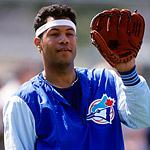The Baseball Hall of Fame’s class of 2011 was announced today as 12-time All-Star Roberto Alomar was voted in along with The Dutchman, pitching great Bert Blyleven.

With Alomar narrowly missing enshrinement last year, his call to the Hall was considered to be a sure thing this time around and indeed it was. Alomar was an incredible talent both on the field and at the plate, and he looks to be the first Hall of Fame inductee to be pictured in a Toronto Blue Jay’s cap.

Alomar came up with the San Diego Padres in 1988 but made a name for himself with the Blue Jays, where he helped guide them to back-to-back World Series titles in 1992-1993.

Blyleven’s Hall of Fame status, however, wasn’t such a sure thing. With 287 wins yet only two All-Star appearances, Blyleven had yet to garner enough votes for enshrinement until this year, his 14th year on the ballot.


My memories of Bert were that of watching him pitch from behind home plate and witness from a batters perspective the break of his incredible curve ball and famous change-up delivery. I also have a fond memory of photographing Blyleven during the 1987 World Series, the first of 19 World Series that I have covered to date.

Fellow standout pitcher Jack Morris looks like he’s next in line to enter the Hall, and in my opinion, deservedly so. He was the dominant pitcher in the American League, if not all of baseball, during the 1980’s.

Now it’s time to air a question that I have had for a number of years. If a player of Blyleven’s stature makes it into the Hall of Fame (and I don’t disagree with Bert’s election at all), what happened to Harold Baines? With 2, 866 hits to his credit and six trips to the All-Star game, how is it that he had received barely enough votes to stay on the ballot? Tell me what I’m missing here. Nothing against Edgar Martinez, but when comparing Martinez, who finished last years voting with 36.2% of the vote with Baines at 6.1%, I can only shake my head in disbelief. And today comes word that Harold received only 4.8% of the vote, thus falling off the ballot entirely. What a shame.

Congratulations to Messrs. Alomar and Blyleven on their inclusion into Baseball’s elite club. But what an injustice it was by letting Baines fall off the ballot entirely.





Regarding your comment about Baines, what has been your experience or knowledge about a player’s willingness to agree to post-game interviews and their likelihood of the writers voting for them in the Hall of Fame balloting? Blyleven has said that he was admittedly cold to a lot of the reporters when they would request post-game interviews and he suggested that as being a contributing reason as to why he was left out of the Hall for so long. Have you heard or known about writers that will refuse to vote for a player because they had basically made their jobs more difficult while they were playing? I don’t know if that’s the case for Baines or not, but perhaps it has something to do with it. Or perhaps Baines just didn’t make enough of the writers’ headlines when he was playing for him to stick out in their recollections when they are voting.
Since I’m not a member of the BBWAA, I can’t accurately comment on your question equating a players willingness to agree to post-game interviews (or lack thereof) to their chances of making the Hall of Fame. I have covered baseball on a regular basis as a photographer for over 26 years and have seen many players break into the big leagues, retire and then become eligible for the Hall of Fame and it’s my personal opinion that a player such as Baines, sporting the statistics he owns, should have at the very least received enough votes to stay on the ballot. Perhaps your analogy that he didn’t make enough headlines had something to do with it. The BBWAA voting members obviously had their reasons. I just wish I understood them a bit better. It will be interesting to see how he fares down the road with the Veterans Committee.